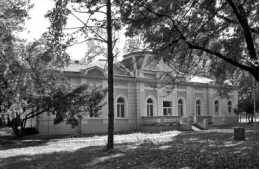The construction of the Maldeghem castle in Novi Kneževac occurs at the end of a long construction practice of raising homes of immigrants in the center of large estates. The basic concept belongs to the representative construction of summer houses from the end of the XIX and the beginning of the XX century built in the then dominant eclectic style. In designing his part of the architect, he has respected all the natural beauties of the ambience, fitting it into space and thereby inextricably tying the function, shape and natural environment.
Although Dusan Popovic points out that Serb families received the Hungarian language for “practical” reasons, while preserving their faith and loyalty to the nation, a change in religion and nation came through marital ties and inheritance. By inheritance and richness, they were transferred into the hands of other owners, so there are several times two or three castles in one place, built by direct heirs or successors from their relatives, as is the case in Novi Kneževac.
After the death of Djordje Servisko, the last direct descendant of the famous noble, the Serbian family Servi in Novi Kneževac, the great estate was inherited by his nephew Katarina, with whom he lived in a wild marriage, married first to Schulpe, then to Ritmajster Lukač, as well as her children from the first marriage. Catherine’s daughter, Albertina, married Eduard Grinenberg, Captain of the Imperial Army. From that marriage was born the daughter of Georgina, who marries Artur Maldeghem, the Imperial army officer, who was in high office at the court. After the death of his parents, Georgina and Count Arthur Maldeghem inherit 1880 acres of land from Kupusina and 300 acres towards Black Bara.
The family of Count Maldeghem did not live in Novi Kneževac, but they rented their property to Lederer from Choke. Since they never gave up the new estate, in 1910 they built a castle-castle dedicated to St. Hubertus, the protector of hunters. Stela sa likom sv. Hubertus, made in a shallow relief, is still at the entrance of the castle. After the construction of the castle was used by their uncle Emil Talijan, who placed his hunting trophies here.
The castle of the Count of Maldeghem was built as a freestanding, terraced building, surrounded by a cultivated park where trees of rare trees have been preserved to this day, and a round fountain is in front of it. The basic concept is determined by the idea of the “Polish castle” as they were built in the last decade of the 19th and early 20th centuries with the stylistic characteristics of the eclectic. Rectangular is the basis, approximately symmetric arrangement of space, except for minor deviations in the internal organization of space. It is dutifully oriented with the mansard elevation of the central part of the roof. The main entrance is on the longitudinal side located in the central, shallow rizalite, which once, according to the old postcard, ended in a balustrade at the corners of the marked acrobatics, and centrally wavy, baroque tympanon with a vase on the crown. At the same level, with an irregular triangle,marked by two lateral columns, two shallow rhizalites are placed centrally on the side wings. In the horizontal, the facade is made of cordon profiled wreaths, and in the attic there is a series of denticles. On the front facade the apertures are symmetrically arranged. Sideways from the central entrance, which is devastated over time, runs from four rhythmically arranged arched windows with a “T” split window. Below the window there used to be balustrades. The openings are marked with a canalized pilastry bearing secessional motif in the shape of a drop with a toothed array, as it appears above the hole leaning against the corona wreath.Sideways from the central entrance, which is devastated over time, runs from four rhythmically arranged arched windows with a “T” split window. Below the window there used to be balustrades. The openings are marked with a canalized pilastry bearing secessional motif in the shape of a drop with a toothed array, as it appears above the hole leaning against the corona wreath.Sideways from the central entrance, which is devastated over time, runs from four rhythmically arranged arched windows with a “T” split window. Below the window there used to be balustrades. The openings are marked with a canalized pilastry bearing secessional motif in the shape of a drop with a toothed array, as it appears above the hole leaning against the corona wreath.
The wall cloth is between the holes made in the imitation of rectangular stone blocks. In front of the main entrance there is a terrace embroidered with stone balustrade. The lateral façades were resolved in the same way, while the façade of the façade has undergone changes in time, and today it is a simple, flat wall cloth with flat openings for all openings.
The roof is complex, covered with eternal plates, sometimes with acrobatics on top.
The last owner of the castle, Carlo Maldeghem, who had no descendants, left the Novi Kneževac in 1950 and moved to Germany where he died.
THE CULTURAL CENTER BUILDING


0 comments on “THE CULTURAL CENTER BUILDING”